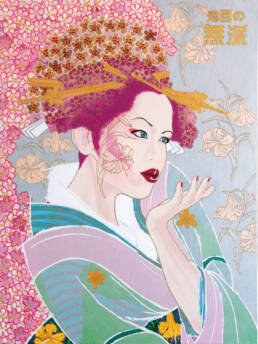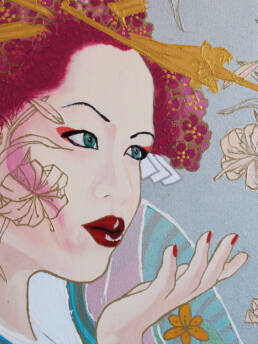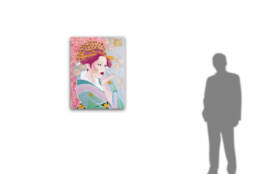Blue Green Olga
It is hard not to paint beautiful women when your friend is Nana Monda. I find myself more and more inspired by works of my friends. I think I have finally made my own worldwide clan of artists- those whose works/practices inspire me to do more and to bring more. I am now considering doing a series of bijin-ga (paintings of beautiful women) named Nana as homage to Nana Monda´s work. I just need to ask her for her approval and I guess this way is good as any.
Blue Green Olga is based on Geigi by Utamaro from Five Shades of Ink in the Northern Quarter series. Geigi is a term synonymous to geisha and it is used more in Niigata. On the original print geigi looks like she is inviting someone or pointing to something, but I wanted to make it a more cheerful, bursting with life, mad in love, the spring moment. My Olga is blowing kisses to a leaving lover and I think this mood is a continuation of the song Blue Green Olga by Jon Spencer’s Blues Explosion. The explosion of a teenage love! I think my next painting will be a continuation of this love – Billy Idol´s Sweet Sixteen.
I´ve been asked to do a portrait of specific person and I had to say no. Same as (I Think Her Name’s) Debra, I did a mishmash of different women’s faces, combining and blending different parts together, to achieve an imagined attitude. They are neither Asian nor Caucasian. Nor are they geisha. They are just beautiful women.
To honor the name of Jon Spencer´s song, kimono is done in pastel green and blue where I kept a transparent effect of the original print. Pink parts are there to connect kimono to sakura. Her eyes are too green and blue. Additional signature in the painting is mon which I created a few years back, a golden lily on the sleeves of kimono reflecting golden lilies in the background and on obi.
She is blue green.
She is blue.
And I love her, yes I do.
Technique: acrylic on canvas
Size: 80 x 60 cm
Year: July 2020
Availability: In Collection of
Foundation “Center Duga Art”
Bijin-ga (Paintings of the Beautiful Person)
When you have a friend like Nana Monda, it is hard not to enjoy bijin-ga. Her paintings have been constantly influencing my work. For me she is a truly living master of bijin-ga. Next in line is my friend Nataša Konjević, whose fantastic mixture of magic and portraits never fail to amaze me.
Bijin-ga is commonly translated as Portraits of beautiful women but it should be translated as Portraits of beautiful person, an individual, something that reflects inner beauty, gender is not specified at all. This leaves opening to gender fluidity in my future paintings from this series.
In my bijin-ga I will try to grasp iki – いき feeling, a beautiful sensual situation or a personal charm, where a viewer is a discreet witness to this moment.



